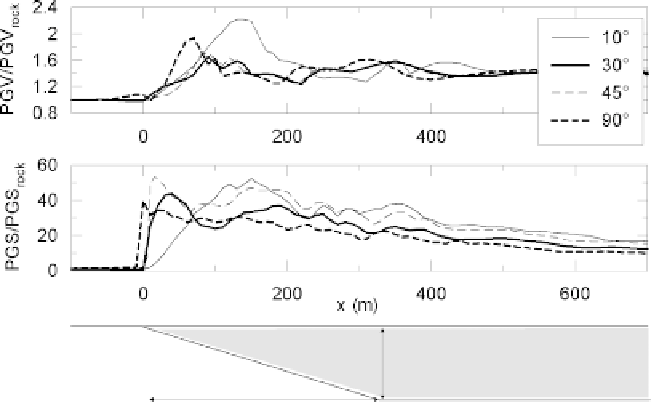Geoscience Reference
In-Depth Information
2.2. EVALUATION OF
PGS
INTHE PRESENCE OFSTRONG LATERAL
HETEROGENEITIES
Damage to buried structures is often concentrated in areas with variable subsurface con-
ditionsandnon-uniformgroundpropertiesinhorizontaldirection.Thiswasobservedfor
instance after the 1994 Northridge (Trifunac and Todorovska, 1997) and the 1995 Kobe
earthquakes (Takada et al., 2002) in regions characterized by strong lateral discontinu-
ities,asaninclinedgroundsurfaceoraninclinedsoil-bedrockinterface.Thesesituations,
where the correlation between
PGS
and
PGV
is typically worse than in cases where the
soilprofileconsistsofhorizontallayers,arenottakenintoaccountbythesimplesolutions
for ground strainevaluation, suchas eq. (18.1) or eq. (18.3).
Thefirststudiesofthe
PGS
-
PGV
dependenceinthepresenceofstronglateralvariationof
soilpropertiesarereportedbyO'RourkeandLiu(1999).Morerecentinvestigationshave
been performed by Scandella and Paolucci (2006), through a set of parametric analyses
by2Din-planenumericalsimulationsofseismicwavepropagationbyaspectralelement
code(Facciolietal.,1997;Stupazzini,2004).Resultsshowninthefollowingrefertothe
horizontal strain, calculated at ground surface (
PGSa
). A typical example of numerical
results is shown in Figure 18.4, where it is clear that
PGSa
and
PGV
occur at the same
spatial location (
x
denotes distance from the basin edge) only for low values of the dip-
ping angle
10
◦
)
, while the larger is the dip angle the larger is the spatial distance
between points where the maximum value of either
PGSa
or
PGV
occurs.
(α <
α
H
L
Fig. 18.4. A simplified open basin model, separated laterally by the bedrock by a
dipping edge withangle
, foraparametric numerical study of the
PGSa
-
PGV
relationship in thepresence of strong lateral discontinuities. Adapted fromScandella
and Paolucci (2006)
α

